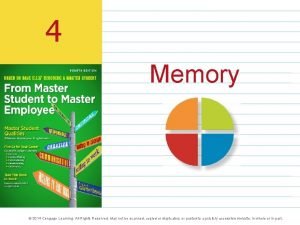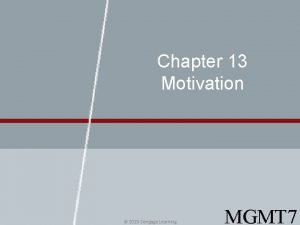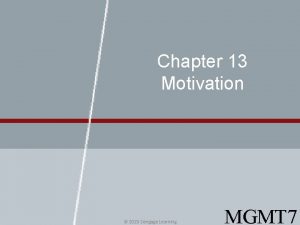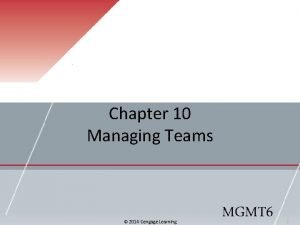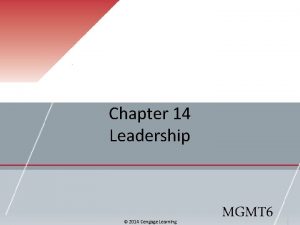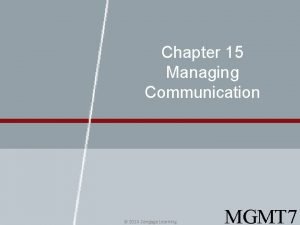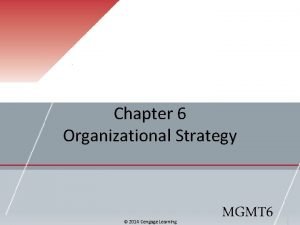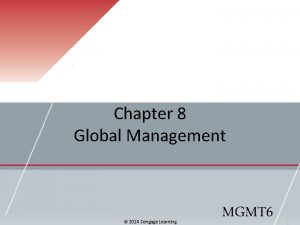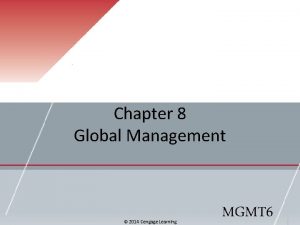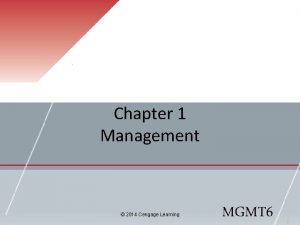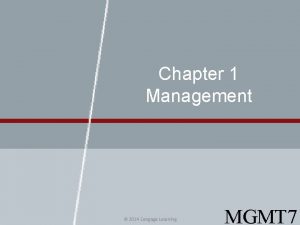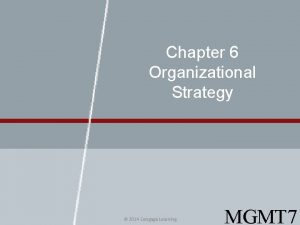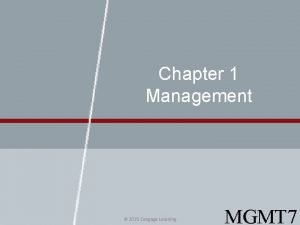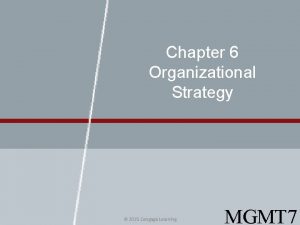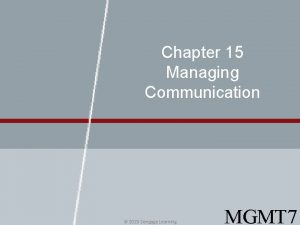Chapter 13 Motivation 2014 Cengage Learning MGMT 7






















- Slides: 22

Chapter 13 Motivation © 2014 Cengage Learning MGMT 7

13 -1 explain the basics of motivation 13 -2 use equity theory to explain how employees’ perceptions of fairness affect motivation 13 -3 use expectancy theory to describe how workers’ expectations about rewards, effort, and the link between rewards and performance influence motivation 13 -4 explain how reinforcement theory works and how it can be used to motivate 13 -5 describe the components of goal-setting theory and how managers can use them to motivate workers 13 -6 discuss how the entire motivation model can be used to motivate workers © 2014 Cengage Learning

Motivation Is… The set of forces that initiates, directs, and makes people persist in their efforts to accomplish a goal. © 2014 Cengage Learning

The Basics of Motivation • Effort and performance • Need satisfaction • Extrinsic and intrinsic rewards • How to motivate with the basic model of motivation 13 -1 © 2014 Cengage Learning

Effort and Performance Job Performance = Motivation x Ability x Situational Constraints © 2014 Cengage Learning 13 -1

Need Satisfaction • Needs – the physical or psychological requirements that must be met to ensure survival and well-being • • 13 -1 A person’s unmet need creates an uncomfortable, internal state of tension that must be resolved. People are motivated by unmet needs Managers must learn what those unmet needs are, and address them. Once a need is met, it no longer motivates. © 2014 Cengage Learning

Predictions of Need Theories • Maslow – needs are arranged in a hierarchy from low to high; people are motivated by their lowest unsatisfied needs • Alderfer – people can be motivated by more than one need at a time • Mc. Clelland – the degree to which particular needs motivate varies from person to person 13 -1 © 2014 Cengage Learning

“What Leads to Effort? ” • Higher-order needs will not motivate as long as lower-order needs remain unsatisfied. • It’s difficult to predict which higher-order needs will motivate employees’ behavior. • The relative importance of the various needs may change over time. © 2014 Cengage Learning 13 -1

Extrinsic and Intrinsic Rewards • Extrinsic rewards – tangible and visible to others and are given to employees contingent on the performance of specific tasks or behaviors • Intrinsic rewards – the natural rewards associated with performing a task or activity for its own sake © 2014 Cengage Learning 13 -1

Motivating with the Basics • Start by asking people what their needs are • Satisfy lower-order needs first • Expect peoples needs to change • As needs change and lower-order needs are satisfied, create opportunities for employees to satisfy higher-order needs © 2014 Cengage Learning 13 -1

Equity Theory People will be motivated at work when they perceive that they are being treated fairly. In particular, equity theory stresses the importance of perceptions. © 2014 Cengage Learning 13 -2

Forms of Inequity • Underreward – when you are getting fewer outcomes relative to your inputs than the referent • Overreward – when you are getting more outcomes relative to your inputs than the referent © 2014 Cengage Learning 13 -2

Reacting to Inequity • Decreasing or withholding inputs • Increasing outcomes • Rationalize or distort inputs to outcomes • Changing the referent • Employees may leave 13 -2 © 2014 Cengage Learning

Motivating with Equity Theory • Start by looking for and correcting major inequities • Reduce employees’ inputs • Make sure decision-making processes are fair – distributive justice – procedural justice © 2014 Cengage Learning 13 -2

Components of Expectancy Theory Motivation = Valence x Expectancy x Instrumentality Valence -The degree of attractiveness an individual, activity, or object possesses as a behavioral goal. © 2014 Cengage Learning 13 -3

Motivating with Expectancy Theory • Systematically gather information to find out what employees want from their jobs • Take specific steps to link rewards to individual performance in a clear and understandable way • Empower employees to make decisions if management really wants them to believe that their hard work and effort will lead to good performance © 2014 Cengage Learning 13 -3

Reinforcement Theory Behavior is a function of its consequences, behaviors followed by positive consequences will occur more frequently, and behaviors followed by negative consequences, or not followed by positive consequences, will occur less frequently. • Reinforcement contingencies • Schedule of reinforcement © 2014 Cengage Learning 13 -4

Components of Reinforcement Theory • Positive reinforcement • Negative reinforcement • Punishment • Extinction © 2014 Cengage Learning 13 -4

Schedules for Delivering Reinforcement • Continuous • Intermittent – fixed interval – variable interval – fixed ratio – variable ratio 13 -4 © 2014 Cengage Learning

Motivating with Reinforcement Theory • Identify, measure, analyze, intervene, evaluate • Don’t reinforce the wrong behaviors • Correctly administer punishment at the appropriate time • Choose the simplest and most effective schedule of reinforcement 13 -4 © 2014 Cengage Learning

Components of Goal-Setting Theory • Goal specificity • Goal difficulty • Goal acceptance • Performance feedback 13 -5 © 2014 Cengage Learning

Motivating with Goal-Setting Theory • Assign employees specific, challenging goals • Make sure workers truly accept organizational goals • Provide frequent, specific, performancerelated feedback © 2014 Cengage Learning 13 -5
 2014 cengage learning accounting answers
2014 cengage learning accounting answers 2014 cengage learning
2014 cengage learning Chapter 13 medical math
Chapter 13 medical math Chapter 7:10 respitory system
Chapter 7:10 respitory system Chapter 6:2 interpreting word parts
Chapter 6:2 interpreting word parts Chapter 5 learning exercises medical terminology
Chapter 5 learning exercises medical terminology Cengage learning heart diagram
Cengage learning heart diagram South-western cengage learning
South-western cengage learning 2009 delmar cengage learning
2009 delmar cengage learning Cengage learning heart diagram
Cengage learning heart diagram Chapter 1 introduction to medical terminology answer key
Chapter 1 introduction to medical terminology answer key Cengage learning australia
Cengage learning australia Measuring and recording apical pulse
Measuring and recording apical pulse Whille
Whille Cengage learning
Cengage learning Wadsworth cengage learning
Wadsworth cengage learning Cengage learning
Cengage learning Cengage learning plant cell
Cengage learning plant cell Cengage learning
Cengage learning Cengage learning
Cengage learning Brooks cole cengage learning
Brooks cole cengage learning Cengage chapter 7
Cengage chapter 7 Cengage learning
Cengage learning

